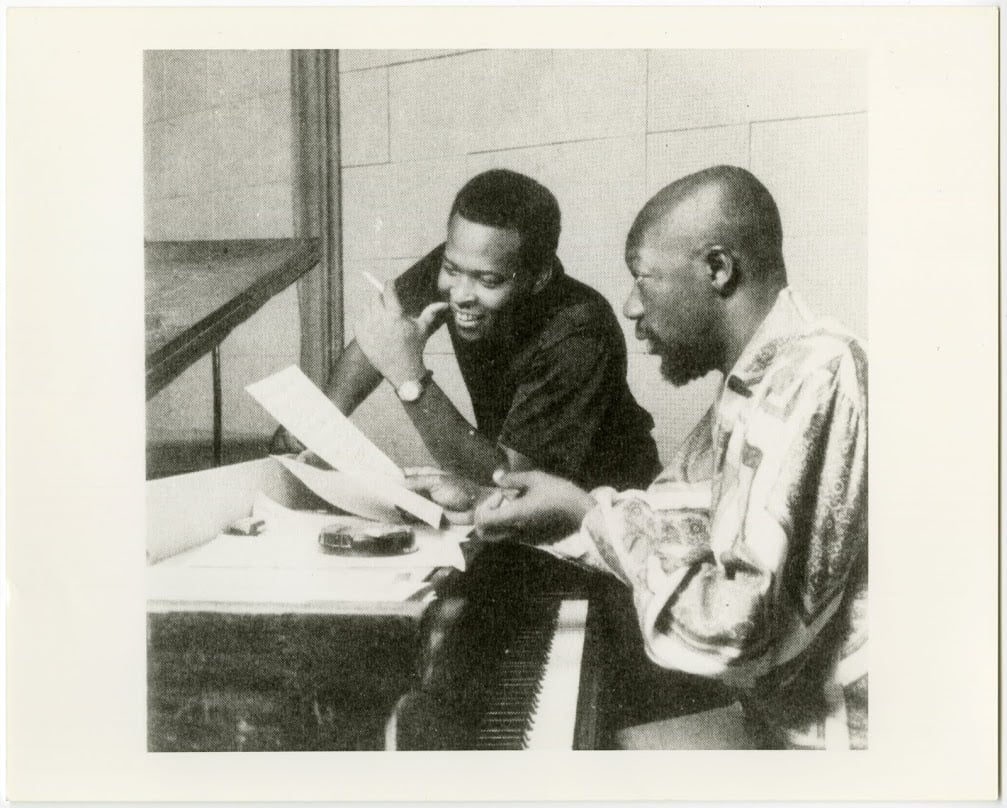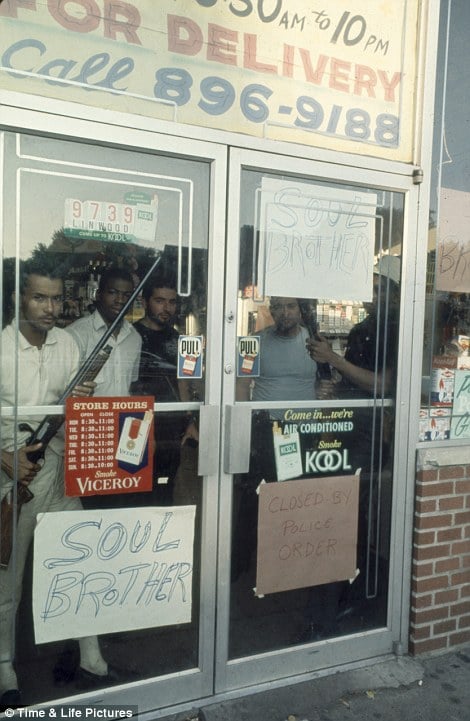 David Porter and Isaac Hayes (at piano) wrote the lyrics for "Soul Man" in 1967. Photo courtesy of Stax Museum of American Soul Music.
David Porter and Isaac Hayes (at piano) wrote the lyrics for "Soul Man" in 1967. Photo courtesy of Stax Museum of American Soul Music.The upbeat music and lyrics may be familiar to many students, but they may not know that it was a tragic moment in United States history that inspired the song: the Detroit riots of 1967. At a time when the American media often linked the black urban working class to crime and violence, Hayes and Porter celebrated a proud, hard working "Soul Man."
In July 1967, a Detroit police tactical squad entered a club called the blind pig that was serving alcohol after hours. The event being held at the club that night was a reception for black Vietnam War veterans, and when officers tried to make arrests, they met resistance. The confrontation escalated, and residents of neighboring streets began to riot, setting fire to stores known for their discriminatory practices and soon to white-owned businesses as a whole. According to the PBS documentary Eyes on the Prize, "Estimates for the number of injured was as high as 600 people, 4,000 residents had been arrested, 5,000 people were homeless, and 682 buildings were damaged. Property loss from fires ran over $45 million."
In Eyes on the Prize, Ron Scott, a citizen of Detroit, explained what he believed led to the violence:
"Inside of most black people, there was a time bomb. There was a pot that was about to overflow, and there was rage that was about to come out. And the rebellion just provided an opportunity for that. I mean, why else would people get upset about the cops raiding the blind pig? They'd done that numerous times before. But people just got tired. People just got tired of it. And it just exploded."
After the riots, President Lyndon Johnson appointed the Kerner Commission to investigate its root causes. In their report, the authors explained, "Our nation is moving toward two societies, one black, one white—separate and unequal. What white Americans have never fully understood—but what the Negro can never forget—is that...white institutions created [the ghetto], white institutions maintain it, and white society condones it." The commission recommended that federal funds be allocated to economic empowerment, but the rising cost of the Vietnam War rendered that a political impossibility.
Washington had offered a diagnosis, but would struggle to administer a cure. A pair of songwriters took a different approach. Hayes described the inspiration for "Soul Man":
"I remember in Detroit, I saw the news flash where they were burning [the neighborhoods]. Where the buildings weren't burnt, people would write ‘soul’ on the buildings. The big thing was 'soul brother.' So I said, 'Why not do something called "Soul Man" and kind of tell a story about one's struggle to rise above his present conditions.' It's almost a tune [where it's] kind of like boasting I'm a soul man—a pride thing. 'Soul Man' came out of that whole black identification."
In the aftermath of the riots, Hayes and Porter made a deliberate decision to counter negative images of black men by focusing on an ordinary person trying to create a better life for himself. The song was a break through hit. "Soul Man" went on to become one of the most popular Stax Records songs of all time, reaching number two on the Billboard Hot 100 in the fall of 1967 and number one on the Billboard R&B chart for seven weeks in a row in October and November of 1967. It won the GRAMMY® Award for Best Rhythm & Blues Group Performance, Vocal or Instrumental. In Soulsville, U.S.A., Rob Bowman writes, "'Soul Man' was an important record, keying in to the then-newly emergent black consciousness that was perhaps best summed up by the phrase 'black is beautiful.' In 1967 the song became an anthem for black America."
Invite students to watch a video of Stax Music Academy performing "Soul Man":
Then answer the following questions:
- How do we shape our own identities?
- How do stereotypes influence the way we see ourselves and others?
- What can individuals and groups do to counter negative images, ideas, and stereotypes?
- What sorts of responses can an individual have to injustice? Can making or listening to music be one of these responses? How so?
- Why was it important for Hayes and Porter to define a "soul man" or a "soul brother" in a positive way?
Go Deeper:
- Find historical images from the aftermath of the 1967 Detroit riots and the recording of "Soul Man."
- Watch musicians and songwriters Isaac Hayes, Booker T, David Porter, and Sam Moore reflect on the origin and meaning of "Soul Man" from an excerpt of the documentary Respect Yourself: The Stax Records Story.
- Download Facing History's The Sounds of Change: An Educator's Guide to Visiting the Stax Museum of American Soul Music
The lesson plans and videos are part of Facing History and Ourselves' latest teaching resource, Sounds of Change, published in partnership with the Stax Museum of American Soul Music in Memphis, Tennessee. The resource's text-dependent questions that accompany both the lyrics and the historical documents are based on the Common Core Anchor Standards for Reading and Literacy in Social Studies. In addition to measuring student understanding of the material covered, the questions will prepare students for the types of questions they will encounter on Common Core State Standards–aligned assessments. Stay tuned next week for our second installment: Breaking the Racial Boundaries.
Do you use music to explore themes of identity in your classroom? Tell us about it—comment below!


